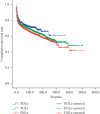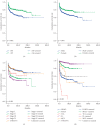Clinicopathological Features, Treatment Strategy, and Prognosis of Primary Non-Hodgkin's Lymphoma of the Duodenum: A SEER Database Analysis
- PMID: 32399459
- PMCID: PMC7201497
- DOI: 10.1155/2020/9327868
Clinicopathological Features, Treatment Strategy, and Prognosis of Primary Non-Hodgkin's Lymphoma of the Duodenum: A SEER Database Analysis
Abstract
Objective: Primary duodenum lymphoma (PDL) is extremely rare with limited data available in the literature. In this study, we sought to describe clinical features and identify factors affecting survival in patients with PDL using a large population cohort.
Methods: The Surveillance, Epidemiology, and End Results (SEER) database was queried from 1998 to 2015.
Results: A total of 1060 cases of PDLs were identified. Clinicopathological features as well as survival data of PDLs were analyzed and compared with 10573 primary gastric lymphomas (PGLs) and 3239 primary small intestinal lymphomas (PSILs) from the SEER database. PDL patients were younger in age (60.96 ± 15.205), and the proportion of stage I (53.21%) was higher in Ann Arbor staging. The proportion of PDLs treated by surgery (8.68%) is the lowest among PDLs, PGLs, and PSILs. The DSS of PDLs were significantly better than those of PGLs and PSILs, respectively (10-year survival rate: 21.24% vs. 20.40%, P=0.027; 10-year survival rate: 21.24% vs. 16.79%, P=0.001). Age, gender, Ann Arbor staging, and histological type were regarded as independent prognostic factor for the DSS by multivariate analysis (all P < 0.05). Patients with <65 years, female, stage I, and FL were found to be significantly associated with good DSS. The treatment modality (surgery vs. conservative treatment) was not statistically related to DSS. The proportion of PDL patients who received surgical treatment gradually decreased from 15.60% in period 2 to 5.26% in period 4.
Conclusions: The clinicopathologic features of duodenal lymphoma were significantly different from those of gastric lymphoma and small intestinal lymphoma. The prognosis of PDLs was significantly better than those of the other two groups, and there was no statistical survival benefit from surgery in PDLs.
Copyright © 2020 Guoliang Zheng et al.
Conflict of interest statement
The authors declare that they have no conflicts of interest to this work.
Figures



References
-
- d’Amore F., Brincker H., Grønbaek K., et al. Non-Hodgkin’s lymphoma of the gastrointestinal tract: a population-based analysis of incidence, geographic distribution, clinicopathologic presentation features, and prognosis. Danish Lymphoma Study Group. Journal of Clinical Oncology. 1994;12(8):1673–1684. doi: 10.1200/jco.1994.12.8.1673. - DOI - PubMed
MeSH terms
LinkOut - more resources
Full Text Sources
Medical
Miscellaneous

